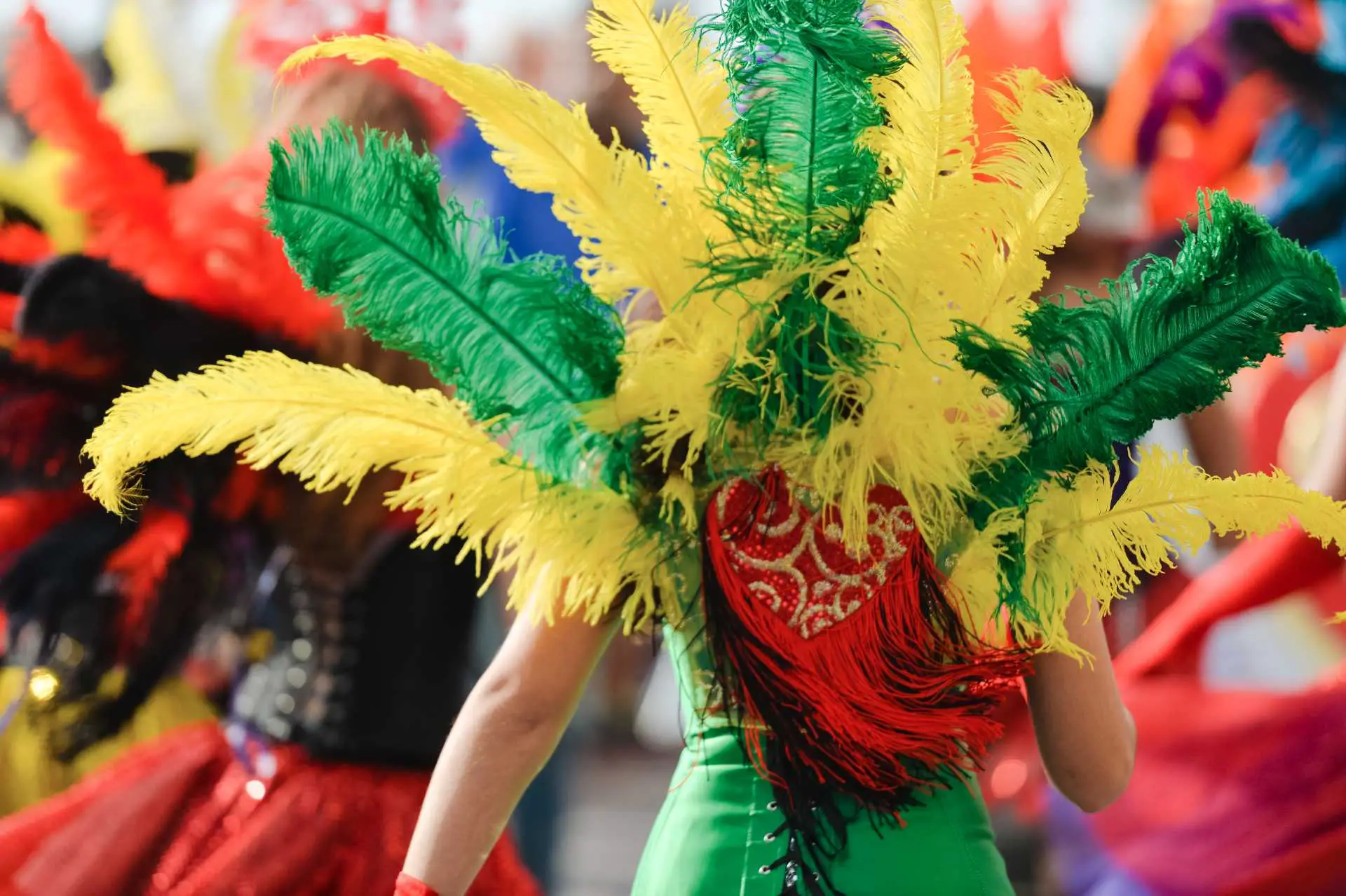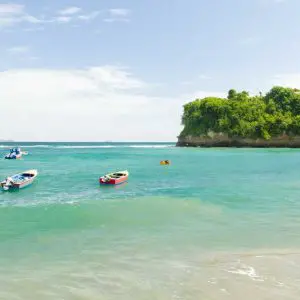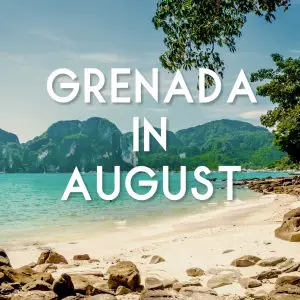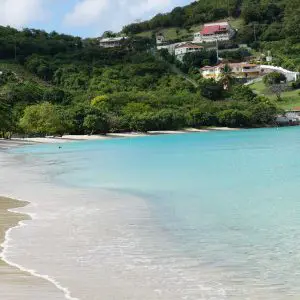Grenada has a side that many have never seen before. The Spice Isle, as it’s known for its large role in exporting nutmeg and mace, is a small island located directly north of Trinidad and Tobago. In addition to its gorgeous beaches, it’s a destination for tourists and adventurers seeking the revelry of Spicemas, Grenada’s Carnival.
What is Grenada’s “Spicemas” Carnival? Spicemas is Grenada’s Carnival. This 10-day celebration of slavery’s end combines parades, pageantry, competitions, displays, great food, and good rum. It takes place in August, about five or six months later than other carnivals around the world.
Not only is it celebrated at a different time than other carnivals throughout the world, but it also has a rich history that celebrates the culture that makes Grenada a world-class destination. How exactly is Grenada’s carnival different than others – and what makes it so extraordinary?
What is Spicemas?
Grenada’s Spicemas Carnival you’ve ever seen, experienced or heard. While the end of slavery is widely celebrated throughout the Caribbean and West Indies with parties and parades, Grenada takes this to a whole new level. The people of Grenada make this celebration truly one of a kind, an experience that most only dream of witnessing firsthand.
Spicemas is a mixture of all things colorful and music that’s traditional to only Grenada. Anyone in attendance is free to be who and how they are. There is no judging – and there are no rules, it’s all just fun and togetherness. Spicemas embodies age-old traditions that symbolize human nature and a spirit that can never be broken.
The traditions of Spicemas stem from the people taken from Africa to become slaves in the Caribbean to work in the direst conditions. Yet somehow, these people managed to preserve some of the traditions they knew from their homes. Rich, African traditions from lands that were otherwise untouched by outsiders.
While Caribbean Carnival as a whole is founded upon the customs of the African people who were slaves, the people of Grenada have developed a Carnival all their own. They even have their own music that grew out of their Spicemas celebrations.
When is Spicemas?
Unlike traditional Caribbean Carnivals, the people of Grenada celebrate in August. This year Spicemas is August 1 – 11, 2020. Since 1981, the first Monday and Tuesday of every August have been dedicated to Spicemas. August 1 is Emancipation Day, which makes the beginning of August the perfect time to celebrate.
it was decided in 1981 that Carnival would be celebrated in August, in order to allow late-season tourists to engage in the festivities.
J’ouvert
This is the name for the official first day of Spicemas. This is originally thought to be from a French Creole word, which means dawn. Naturally, the first day of the big Spicemas party starts at daybreak. And just like any real party it lasts all day and all night.
How Long Does Spicemas Last?
Although the planning for the next Spicemas begins almost immediately following the ending of one Spicemas, the celebration itself lasts ten days. And each and every minute is jam-packed with as much culture and tradition as you can possibly imagine.
What Happens at Spicemas?
With almost a full year of planning, you’d expect every single moment of Spicemas to be filled to the brim with as many events and activities as possible. And just as you’d expect from the Spice Isle, the people of Grenada deliver.
The days of Spicemas are celebrated with all kinds of events, incorporating all of the rich traditions from their African heritage, mixed with what they’ve learned from the French, along with existing rituals from the natives that inhabited the island long before anyone else. Sprinkle in some British customs, and you have quite a magical mix that is Spicemas.
Jab Jab Fest
With a name like this, you know it has to be a good time. Let’s start by introducing you to the Jab Jab himself. Jab Jab comes from the French word for devil, which is exactly what the people of Grenada dress like for this festivity. While the people of Grenada and Trinidad battle over who started this tradition, there’s no question of why it started.
Slaves would watch their owners at parties that they weren’t allowed to attend, oftentimes calling them devils. Dressing up as their devilish owners became somewhat of a tradition that evolved into what’s known as “jab jab” or playing devil.
On this celebration day, participants put on costumes and cover themselves with dark oil. They put on horned hats made from cattle horns (picture a Viking hat) and parade in the streets. If you need a visual image, check out the video below.
Some wear chains. Others pretend to eat things that resemble body parts. Someone that’s not native to Grenada might see these things as gross or odd, but to those from the island, they’re just regular parts of a traditional Jab Jab Fest.
This is all part of how the Grenadian people celebrate the freedom of those that were once enslaved while reflecting on the true history of the past. The oil or tar and cattle horned hats are pieces of history for those who have ancestors that were once slaves in the Caribbean.
Celebrating Jab Jab Fest
Anyone that wants to participate in Jab Jab fest should just plan to get really, really messy. If you don’t show up covered in enough oil, the locals will help you out with one of their oil drums stationed throughout the streets. They also have stations where you can put on or switch out your existing shower cap.
All throughout the streets, children and grown-ups wear their Jab Jab outfits while they celebrate. There are no parade fees to join in; the running theme here is freedom. If you want to join, go ahead. If you want to wear a costume, great. Taking part in Jab Jab fest is meant to make you feel empowered and to respectfully pay homage to those that made great sacrifices to achieve the freedom they deserved.
10 to 10
Music is a huge part of any culture, and Spicemas is no different. Music is a constant throughout the entire festival. This event is dedicated to Soca music, which is similar to Reggae.
During the 10 to 10 event, Soca bands take over a local park and play all the Soca music you could ever ask for. Sipping some rum while overlooking the ocean and listening to the sounds of Soca music sounds almost as good as it can get.
Children’s Carnival Frolic and Junior Calypso Monarch
Who says Spicemas is only for grown-ups? While children are allowed and encouraged to embrace traditions during parades and major events, this one is dedicated just to the young people.
The Children’s Carnival Frolic is for children ages three to sixteen. There are parades to join and pageantry for everyone. This event is usually hosted at Grenada’s Stadium, so they’re able to allow almost anyone to be a part of the action. And everyone wants to watch this; it’s adorable.
For those children that are interested in becoming the Calypso artists of the future, there’s the Junior Calypso Monarch. This doubles as a workshop and a competition. Those that would like to learn the art of Calypso are invited to learn from some of the best, while those that have already honed their Calypso skills can participate in an actual Calypso contest.
Pree Day
Another event held in Grenada’s stadium, this concert is hosted by Tallpree, one of the most well known Soca artists. He also is from Grenada. This is a concert that, of course, goes all day and into the night. A true celebration of Soca music. This is always a week before J’Ouvert.
Spice Addiction Bienvenue
This event is the official welcome party for all of those traveling and participating in Grenada’s Spicemas. Anyone planning to attend this event will need to purchase tickets, but those tickets come with free drinks. The people of Grenada really know how to throw a welcome party.
National Carnival Queen Show
Although Spicemas is full of shows and pageantry, this one takes the cake. The younger women of Grenada compete to win the annual title, in hopes of becoming Grenada’s National Carnival Queen.
With different events within the competition, contestants will wear fancy evening dresses, traditional Grenadian costumes, and perform. Women from all over Grenada spend months, often years, preparing for the event. The title of National Carnival Queen is one that most young Grenadian women would love to win.
White Out
This is one of Grenada’s Spicemas events that actually require tickets, as space is limited. While many of the parties that come before J’Ouvert involve white themes, this one usually takes place on a yacht or otherwise near the water.
Soca Monarch and Groovy Finals
Music and dance are such important cultural elements to the people of Grenada; the Spicemas festival wouldn’t be complete without a music competition. With different categories for performers to enter this event, anyone that has a ticket to this show is in store for quite a concert.
Those that participate really pull out all the stops on their performances. There are colorful and intricate costumes, back up dancers, and detailed sets behind the musicians. It’s just as culturally charged and visually stimulating as you’d expect from a Spicemas event.
Fancy Mas
A long-time tradition of Spicemas, also known as “Pretty Mas.” Participants in this pageant put a ton of time and effort into their costumes so that they can show off during this true display of freedom. Literally, anything goes.
While celebrating the history that Spicemas encompasses, men, women, and even children participate in what’s become a global affair, attracting people from all over the world to come and put their freedom into fashion.
Everyone involved is free to express themselves in any way they’d like. Some do this through extravagant costumes with sequins and feathers. Others do this by wearing very little clothing. Anything and everything is accepted. The only judgment allowed is to judge the judgers; meaning, there’s no judging allowed at all. Pretty Mas is not for those that want to shake their fingers and criticize.
Shortknee Masquerade
Amongst all of the parades you can see in the days long party that is Spicemas, the Shortknee Masquerade is one of the most iconic and recognizable. Right behind the marching of Jab Jabs, the Shortknee Masquerade is quite a spectacle, in one of the most amazingly compelling ways.
While you watch the paraders down the street, you’ll see all kinds of colors, textures, and sounds. All of these represent the two most prevalent cultures in Grenadian heritage, African and French.
The Last Lap
On the Tuesday following J’Ouvert, those that haven’t partied too hard the night and day before will take part in the last lap. But let’s be honest, anyone that’s celebrating Spicemas in Grenada better be prepared to party from sun up on Monday until at least sundown on Tuesday.
The Last Lap is a parade that’s meant to close out the festivities, giving everyone a little time to rest up before they have to start planning again for next year. While bands play and paraders march in colorful costumes, they make one last tour of the streets.
This name is also significant, as the Grenadian Spicemas is sometimes referred to as “The Last Lap” of all Caribbean Carnivals. When Grenada moved their Carnival to the end of the tourism season in August, it’s the last big Carnival celebration. Those that visit various Carnivals can stop in Grenada as their last lap.
What Makes Spicemas Unique?
Besides being celebrated on different dates than other Caribbean Carnivals and having a different name, Grenada’s Spicemas has a few other distinct differences that set it apart from other neighboring islands. Both Jab Jab Fest and the Shortknee Parade are also unique to Grenada’s Spicemas.
Jab Jab Music
As if getting covered in a costume of oil wasn’t means enough of celebrating Jab Jab, an entire musical sound was created around it. Jab Jab music borrows some of the sounds that Soca music provides while adding the drums and chants that come from playing Jab Jab.
Jab Jab music is truly a Grenadian original, as long as you ask someone from Grenada. There’s still a little gray area between who actually started all of the Jab Jab traditions, between Grenada and Trinidad.
Because the two are so close and people would frequently travel between both places when the customs were first blossoming, both sides have a decent case for Jab Jab ownership. But for now, we’ll side with the Grenadians.
Vieux Corp
This is one of the oldest traditions you’ll find at Spicemas. In fact, it started before the slaves were emancipated. In French, Vieux Corps means “dead body.” Anyone that participates in this march wears a mask, to hide their face. This symbolizes the fact that slaves lost their identities when they were stolen from their homes and brought to the Caribbean to work on plantations.
When the tradition first began, slaves would dress up in black gowns which were their way of bringing to light the fact that they’d lost everything they once knew. While the black gowns of the past are still very much a part of the Vieux Corp, you’ll find some of them have a little more color added in.
While the people who wear these costumes walk the streets, they march to traditional drums and stomp their feet to the beat. It’s both eerie and magical, all at once. Some will also wear wooden shoes, often made from mango trees, to demonstrate the heaviness of the feet and ankles of slaves that were once in shackles.
History of Spicemas
Carnival in Grenada started just as other carnivals in the Caribbean. Much of the island population in Grenada arrived there against their own will, brought over from Africa as slaves. In a true testament to the very strength of these people, they were able to maintain some of the cultures that they knew from their native lands, despite the fact that they were forced to stifle their own traditions by their owners.
African Influence
Human slaves were often taken from what used to be West Africa and South Africa. These countries are now…
- Nigeria
- Sierra Leone
- Ghana
- Benin
- Ivory Coast
- Cameroon
- Congo
- The central African Republic
Cultural Exploitation
Each of these lands had a culture that was one-of-a-kind, yet they forced to merge together when their people became slaves. While the slave owners had no interest in helping the people preserve their culture, they did believe in exploiting it, with events such as the “canboulay.”
Canboulay was a nightly ritual during which plantation owners in the Caribbean forced their slaves to march through the streets while using their own native drums and music. Their end goal was to force them into the sugar cane fields where they had to put out the fires that grew too large.
This job was very dangerous, so these were not happy parades, but rather solemn marches what many feared would be their death.
But the cultural threads within the slaves remained strong, and they were able to retain all of this within themselves, despite the inexplicable hardships they were forced to endure.
When slavery was finally abolished in 1834, everyone took to the streets to celebrate. Finally, the once enslaved people were free and were able to do so with the traditions that they brought with them.
French Traditions
When French colonists began to take over the Caribbean, they too brought with them their traditions. One of the French-brought celebrations was the giant party that we know as Mardi Gras, which is done right before Lent. This indulgent fest is offered to get all of the sins out of one’s system before fasting for forty days and forty nights.
In France, this would involve masquerade balls, lavish parties, and parades. There was no shortage of glitz and glam, just as we see today during a traditional Fat Tuesday celebration in New Orleans.
While many French slave owners were celebrating Fat Tuesday with their fancy parties, their slaves were in their quarters having parties of their own. As a means of mocking their owners, slaves would carry on similar traditions.
Many of these customs were combined with the people of the Caribbean, into what we know as carnival.
And Along Came Spicemas
With all of the traditions from both of these very different parts of the world, what we know as Carnival was born. However, the people of Grenada do things a little differently. They’ve turned their version of Carnival into something that’s truly as unique as the individuals that live on the island.
The Independence of Grenada
Until 1974, Grenada was a British colony. On February 7 of that year, Grenada became an independent nation. Grenada itself is one of three islands that form the state of Grenada.
The other two islands are Carriacou and Petite Martinique. While the three islands together fought for and won their independence, Carriacou maintained a little bit of their own identity through their Carnival celebration.
Carriacou Carnival and Shakespearean Mas
While Carriacou is one-third of what we know as Grenada, these islanders stick to the traditional Carnival celebration dates in February. The old Carnival celebrations go along with the days of Lent, just like Mardi Gras in New Orleans.
One of these traditions is the Shakespearean Mas, also known as “Pierrot.” Shakespearean Mas is basically exactly what it sounds like – a parade of poetry. Men dress up in costumes of all colors and parade through the streets reciting Shakespeare!
While Carriacou celebrates Carnival with many of the same events that are traditional of Spicemas, they’ve also created some customs that are unique to their island.
This is something the participants practice doing for months ahead of time. If they mess up any of the words during their monologue, one of their fellow paraders hits them over the head with a stick. Intrigued by this Bard-inspired pageant? Why not see Shakespearean Mas for yourself.
Spicemas Terminology
If you’re hoping to catch a glimpse of Spicemas firsthand, you’ll want to make sure you’re up to speed on all of the lingo. Below is my version of the Spicemas dictionary that can help you sound like you’re in the know when it comes to Spicemas.
Soca
A blend of the words “soul” and “calypso,” Soca music means just that. With a traditional African music foundation, soca blends other elements from the other cultures that are found within Caribbean roots. You’ll hear a little bit of everything, including French. Soca was first heard in Trinidad, but that doesn’t mean it’s not the main music you’ll hear throughout the Spicemas celebrations in Grenada.
Fete
Although “fete” is the French word for party, it’s also a common term the British use for celebrations, too. Many of the parties that lead up to J’Ouvert have names that include fete. While fete is a very traditional French term, we don’t use it a ton in the English language, so it does make a party sound extra exciting.
Wine
Of course, drinking wine might be part of your Spicemas plans, that’s not the wine we’re referring to here. This kind of wine is a traditional dance move that involves a lot of circling hip movements. You’ll see this done often during Spicemas, but don’t be surprised if someone asks you to “take a wine.” Again, that doesn’t mean sip your Pinot Grigiot, they want you to dance, and if you’re at Spicemas, you better oblige.
Bands
Bands are the distinct groups that you’ll find during Fancy Mas. Each band is represented by their matching costumes while representing themes. Kind of like the “krewes,” or teams that create Mardi Gras floats in New Orleans; these bands spend just as much time on their costumes. And, before the costumes are on full display during Pretty Mas, there’s a fashion show for designers to showcase their creations.
Shortknee
There’s an entire parade dedicated to this traditional garb with pants that are just below the knees. Shortknees also wear a screen mask to cover their face and a towel over their head. During the Shortknee Parade, the people dressed as shortknees carry powder that they’ll toss into the crowd.
Ole Mas
Ole Mas, along with Fancy Mas/Pretty Mas, is the name given to one of the specific bands that participate in the J’Ouvert parade day activities. Naturally, these bands wear traditional clothing that’s been featured in the pageants for many years. Shortknees are an example of an Ole Mas band.








